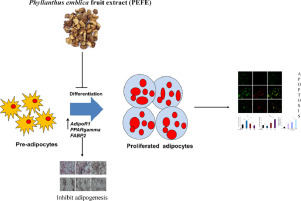Phytomedicine ( IF 6.7 ) Pub Date : 2019-10-31 , DOI: 10.1016/j.phymed.2019.153129 Sri Renukadevi Balusamy , Karpagam Veerappan , Anuj Ranjan , Yeon-Ju Kim , Dinesh Kumar Chellappan , Kamal Dua , Jihyun Lee , Haribalan Perumalsamy

|
Background
Phyllanthus emblica L. (Indian gooseberry) is widely used in the Ayurveda for thousands of years to treat health complications including disorders of the immune system, diabetes, and obesity.
Purpose
For the first time, our study aims to demonstrate the molecular mechanisms of the fruit extract of Phyllanthus emblica (PEFE) involved in the promotion of fat cell apoptosis and alleviation of adipogenesis.
Methods
The active constituents from PEFE were identified using high performance liquid chromatography-mass spectrometry (HPLC-MS). We carried out the 3-(4, 5-dimethylthiazol-2-yl)-2, 5-diphenyl tetrazolium bromide (MTT) assay to evaluate the cytotoxic effects of PEFE using 3T3-L1 pre-adipocytes. The colonogenic assay was carried out to determine the inhibitory effect of 3T3-L1 adipocytes after PEFE treatment. In addition, inhibition of pancreatic lipase activity was performed and the lipolytic activity of PEFE and digallic acid was compared with the well-known standard drug orlistat. Besides, the molecular interaction and ligand optimization between digallic and adipogenesis/apoptosis markers were also carried out. Furthermore, to confirm fat cell apoptosis we have used several detection methods that includes Hoechst staining, PI staining, Oil staining and qPCR respectively.
Results
Digallic acid was identified as a major component in the PEFE. The IC50 values of digallic acid and PEFE were found to be 3.82 µg/ml and 21.85 µg/ml respectively. PEFE and digallic acid showed significant anti-lipolytic activity compared to the standard drug orlistat. In the mature adipocytes, PEFE significantly decreased triglyceride accumulation by downregulating adiponectin, PPARγ, cEBPα, and FABP4 respectively. We further analyzed the expression of apoptosis related genes upon PEFE treatment. Apoptotic process initiated through upregulation of BAX and downregulation of BCL2 resulting in an increased caspase-3 activity. In addition, we have also confirmed the apoptosis and DNA fragmentation in 3T3-L1 cells using Hoechst, PI and TUNEL assays.
Conclusion
PEFE negatively regulates adipogenesis by initiating fat cell apoptosis and therefore it can be considered as a potential herbal medicinal product for treating obesity.
中文翻译:

余甘子果实提取物通过激活凋亡介导的细胞死亡来减弱3T3-L1脂肪细胞的脂质代谢
背景
Phyllanthus emblica L.(印度醋栗)在阿育吠陀中已广泛使用了数千年,用于治疗包括免疫系统疾病,糖尿病和肥胖症在内的健康并发症。
目的
我们的研究首次旨在证明余甘子果实提取物(PEFE)参与促进脂肪细胞凋亡和减轻脂肪形成的分子机制。
方法
使用高效液相色谱-质谱(HPLC-MS)鉴定PEFE的活性成分。我们进行了3-(4,5-二甲基噻唑-2-基)-2,5-二苯基溴化四唑(MTT)分析,以评估使用3T3-L1前脂肪细胞对PEFE的细胞毒性作用。进行结肠形成试验以确定PEFE处理后3T3-L1脂肪细胞的抑制作用。另外,进行了胰腺脂肪酶活性的抑制,并且将PEFE和二没食子酸的脂解活性与众所周知的标准药物奥利司他进行了比较。此外,还进行了双没食子和脂肪生成/凋亡标记物之间的分子相互作用和配体优化。此外,为确认脂肪细胞凋亡,我们使用了多种检测方法,包括Hoechst染色,PI染色,
结果
二没食子酸被认为是PEFE中的主要成分。发现二没食子酸和PEFE的IC 50值分别为3.82 µg / ml和21.85 µg / ml。与标准药物奥利司他相比,PEFE和二没食子酸显示出显着的抗脂解活性。在成熟的脂肪细胞中,PEFE通过分别下调脂联素,PPARγ,cEBPα和FABP4显着降低甘油三酸酯的积累。我们进一步分析了PEFE处理后凋亡相关基因的表达。通过上调BAX和下调BCL2启动凋亡过程导致caspase-3活性增加。此外,我们还使用Hoechst,PI和TUNEL分析证实了3T3-L1细胞的凋亡和DNA片段化。
结论
PEFE通过引发脂肪细胞凋亡来负调控脂肪形成,因此可以认为它是治疗肥胖症的潜在草药。











































 京公网安备 11010802027423号
京公网安备 11010802027423号